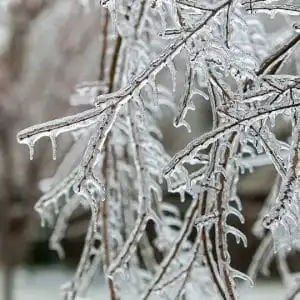Cold spells, fluctuating temperatures, ice, and snow. We escape winter’s harsh elements by going indoors. But how has your landscaping fared? As the snow and ice melt away, it’s time to assess the damage. Look for drooping shrubs, leaning trees, and split or fallen branches around your yard. Before you can welcome spring, you have to fix winter tree and shrub damage.
The Havoc Winter Wreaks
Many factors come into play with winter tree and shrub damage. The health of your greenery before the cold weather hits, the hardiness of each species, and location all have a role in how plants and trees endure the season. Here are the usual suspects that cause the most damage.
Temperature. Some believe that extreme cold weather is what takes a toll on the landscaping. What actually causes a lot of the damage is big fluctuations in temperatures. Prolonged periods of mild winter weather can fool foliage into coming out of dormancy.
Snow and ice. The weight of snow and ice is enough to break branches and limbs, and even topple trees. High winds also cause damage.
Salt damage. Used to safeguard against slippery ice and snow, salt can leach through soils and damage root systems. Salt damage appears in the form of browning leaves, branch dieback, and bar spots in the grass.
Hungry animals and pests. Deer, rodents, insects, and many other creatures search for food during the sparser months, primarily when ice or snow has remained on the ground for long periods of time. Bark and roots are easy prey if accessible.
How to Repair Winter Tree and Shrub Damage
For minor injuries, trees often have the ability to heal themselves. Research has shown that wound dressings and sealants are usually not necessary and sometimes interfere with the natural healing process. Light pruning or removal fixes many minor branch injuries.
Repairing damage from snow and ice buildup on shrubs.
- Assess the damage.
- Gently maneuver bent branches back into place.
- If a branch is broken at the point of origin, prune it by cutting it off flush with the origin branch.
- For a branch that is not completely broken through, secure it in place with a soft tie. Simply remove the tie when it’s healed. If it doesn’t heal after a few weeks, prune it.
Breaks. If a limb is completely severed, focus on protecting the remaining tree or plant. For smaller branches, cut the remainder of the limb at the branch collar to prevent stripping the bark. Use the three-cut method to remove larger branches.
- First, make a cut on the underside of the branch one to two feet out on the branch that you are removing.
- Saw about half way through the limb. Then, make another cut on top of the limb about two to four inches farther out from the first cut.
- Finish by removing the removing the stub.
Repair splits in smaller branches by boring a small hole through the branch above the split. The hole should be a tiny bit smaller than the screw rod or bolt you are using. After you insert the screw, tighten it with a nut or washer. A cable can be used to support a heavier branch until it is healed, but that repair may call for a professional.
When to Call in the Experts
Larger trees require the attention of a tree-care expert. Proper training is necessary to avoid injury. This kind of damage usually requires heavy equipment that professionals can provide. For help assessing and repairing winter tree and shrub damage, call Free Spray Lawn Care at 419-529-5296 and let us handle the heavy work.



Comments (0)
Thanks for your comment!
Thanks for your feedback! Your comments have been successfully submitted! Please note, all comments require admin approval prior to display.
Error submitting comment!
There is a problem with your comment, please see below and try again.